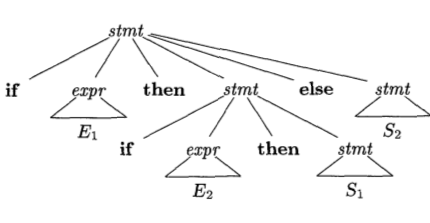Ambiguous Grammars
1 Grammar rewrite
We say that two grammars \(G\) and \(G'\) are equivalent if they define the same language.
\[ L(G) = L(G') \]
Even if two grammars \(G\) and \(G'\) have the same language, they may be quite different and have different properties.
2 Ambiguity of grammars
A grammar \(G\) is ambiguous if there exists at least one sentence \(x\in L(G)\) with two distinct parse trees.
2.1 Some theoretical result
There exists an inherently ambiguous language. Namely, there exists some langauge \(L\subseteq\Sigma^*\) such that every grammar \(G\) that defines \(L\) must be ambiguous:
\[ L(G) = L \implies G \mathrm{\ is\ ambiguous} \]
Recognizing ambiguity of a grammar is undecidable.
2.2 Ambiguity of arithmetics
\[ \begin{eqnarray} E &:& \mathrm{Number}\ |\ E + E\ |\ E * E \end{eqnarray} \]
Given a string \(x = a + b * c\) where \(a, b, c\) are tokens of type \(\mathrm{Number}\). There are two distinct derivations of \(x\), and have the following parse trees:
E E
/ | \ / | \
E * E E + E
/ | \ | | / | \
E + E c a E * E
| | | |
a b b c2.3 Ambiguity of if-then-else
Another example of ambiguous grammar is in the definition of if-then-else in procedural languages.
stmt : if expr then stmt
| if expr then stmt else stmt
| other...
Consider the sentence:
if E1 then S1 else if E2 then S2 else S3There is only one parse tree:

But now, consider another sentence:
if E1 then if E2 then S1 else S2This is known as the dangling-else statement.
It has two parse trees:
| Tree 1 | Tree 2 |
|---|---|
 |
 |
Can you come up with an instance for E1, E2 such that the two parse trees execute different statements (S1, S2, or none).
3 Elimination of ambiguity using grammar rewriting
The objective is to rewrite a grammar \(G\) to \(G'\) such that:
- \(L(G) = L(G')\)
- \(G'\) is not ambiguous.
This is not always possible due to Parikh’s theorem.
Even if it’s possible, it cannot be solved algorithmically due to Post’s theorem.
3.1 Fixing ambiguity in arithmetics
3.1.1 Intuition
Consider a potentially ambiguous expression:
1 + 2 * 3 + 4 * 5A factor is either a number or an expression enclosed by parentheses.
A term is one or more factors multiplied or divide together. \[ \mathrm{term} : \mathrm{factor} * \mathrm{factor} * \dots \]
A expression is one or more terms added (or subtract) together. \[ \mathrm{expression} : \mathrm{term} + \mathrm{term} + \dots \]
3.1.2 The ambiguous arithmetics grammar
\[ \begin{eqnarray} E &:& \mathrm{Number} \\ &|& E\ *\ E \\ &|& E\ /\ E \\ &|& E\ +\ E \\ &|& E\ -\ E \\ &|& (\ E\ ) \end{eqnarray} \]
Let’s fix it by introducing terms and factors.
\[ \begin{eqnarray} E &:& \mathrm{Term} \\ &|& \mathrm{Term} + E \\ &|& \mathrm{Term} - E \\ \mathrm{Term} &:& \mathrm{Factor} \\ &|& \mathrm{Factor} * \mathrm{Term} \\ &|& \mathrm{Factor} / \mathrm{Term} \\ \mathrm{Factor} &:& \mathrm{Number} \\ &|& ( E ) \end{eqnarray} \]
Is
1 + 2 * 3a sentence of the new grammar?How many distinct parse trees can be constructed for
1 + 2 * 3?
3.2 Fixing ambiguity of dangling-else expressions
3.2.1 Intuition
We distinguish two types of
if-thenstatements:Matched statementsIt is either a non-if statement, or a complete
if-then-elsestatement.Open statementsIt is either a
if-thenstatement (without else), or it is aif-then-elsestatement but the else-statement is an open statement.
3.2.2 The ambiguous grammar
\[ \begin{eqnarray} \mathrm{stmt} &:& \mathbf{if}\ E\ \mathbf{then}\ \mathrm{stmt} \\ &|& \mathbf{if}\ E\ \mathbf{then}\ \mathrm{stmt}\ \mathbf{else}\ \mathrm{stmt} \\ &|& \mathit{others}\dots \end{eqnarray} \]
3.2.3 The unambiguous grammar
\[ \begin{eqnarray} \mathrm{stmt} &:& \mathrm{matchedStmt} \\ &|& \mathrm{openStmt} \\ \mathrm{matchedStmt} &:& \mathbf{if}\ E\ \mathbf{then}\ \mathrm{matchedStmt}\ \mathbf{else}\ \mathrm{matchedStmt} \\ &|& \mathit{others}\dots \\ \mathrm{openStmt} &:& \mathbf{if}\ E\ \mathbf{then}\ \mathrm{stmt}\\ &|& \mathbf{if}\ E\ \mathbf{then}\ \mathrm{matchedStmt}\ \mathbf{else}\ \mathrm{openStmt} \end{eqnarray} \]
- Is
if E1 then if E2 then S1 else S2a sentence of the revised grammar? - Can you construct two distinct parse tree for it?
4 Grammar Design
Rewriting grammar to remove ambiguity cannot be automated. What if we can avoid ambiguity by changing the syntax of the language.
4.1 Redesigning arithmetics
\[ \begin{eqnarray} E &:& F \\ &|& F + F \\ &|& F * F \\ F &:& \mathrm{Number}\ |\ ( E ) \end{eqnarray} \]
- Is
1 + 2 * 3part of the language \(L(E)\)?
No: it needs to be:- 1 + (2 * 3), or
- (1 + 2) * 3
- Is the new language ambiguous?
No. - Is the new language design a good idea?
Probably not.
4.2 Redesigning if-then-else
\[ \begin{eqnarray} \mathrm{stmt} &:& \mathbf{if}\quad E\quad \mathbf{then}\quad\{\quad \mathrm{stmt}\quad\} \\ &|& \mathbf{if}\quad E\quad \mathbf{then}\quad\{\quad \mathrm{stmt}\quad \}\quad \mathbf{else}\quad \{\quad \mathrm{stmt}\quad\} \\ &|& \mathit{others}\dots \end{eqnarray} \]
Is
if E1 then if E2 then S1 else S2part of the language \(L(E)\)?
No: it needs to be:if E1 then { if E2 then { S1 } else { S2 } }Is the new language ambiguous?
No.Is the new language design a good idea?
Probably yes.
4.3 Leave the ambiguity in the grammar
Here is a quote from the ANTLR guide:
expr : expr '*' expr | expr '+' expr | Number ;The problem is that this rule is ambiguous for some input phrases. …
This is a question of operator precedence, and conventional grammars simply have no way to specify precedence. Most grammar tools, such as Bison, use extra notation to specify the operator precedence.
Instead, ANTLR resolves ambiguities in favor of the alternative given first, implicitly allowing us to specify operator precedence.
The parser will choose the first rule that applies. Therefore, if we want a particular operator to take higher precedence, just have it before other rules.
expr : expr '*' expr
| expr '+' expr
| ...
;The * operator will have higher precendence as +, and only one parse tree will be generated.